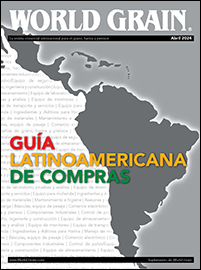“The Midwest is wet right now, which is causing concerns about delayed planting,” the USGC said. “As of April 16, 6% of the U.S. corn crop was planted, half of last year’s pace and behind the 5-year average pace of 9%. Still, it’s a little early to be overly concerned about these figures, though greater delays may signal a switch from corn to soybeans.”
“The IGC GOI maize sub-Index dropped by 6% in the period since the February Grain Market Report (GMR), slumping to a near-one year low,” according to the International Grains Council’s (IGC) GMR at the end of March. “Steep declines were noted in Argentina and the U.S., with spot quotations both now at a wide discount to equivalent Black Sea values.”
A fall in nearby (May) futures was tied to technical and speculative selling, “as non-commercial funds turned more bearish, switching their previous net long position to a net short in the second half of March.”
Prospects for record harvests in South America weighed, as traders eyed stiffer export competition in the months ahead, the IGC said.
The IGC’s index for barley was broadly unchanged.
“Quotations at all origins were underpinned by solid buying interest,” the council said.
The IGC put U.S. Gulf export quotations for soybeans at about 1% lower on the month.
“In Australia, values were also fractionally weaker month-over-month, as continued support from prospects for a heavily reduced outturn was outweighed by pressure from grower selling,” the IGC noted.
Oats futures in the United States declined by a net 9% month-over-month, mainly in technical activity, the IGC said. Tight supplies bolstered prices in the U.K. while there was little change in Finland. In Australia, values strengthened slightly, but following the good harvest, prices remained lower than last season.
“In the E.U., German milling rye prices were boosted by tightening supplies ahead of the new crop,” the IGC said. “Reluctant farmer selling amid solid interest from the local processing industry also supported.”
The IGC forecasts world maize production at 1.024 billion tonnes in 2017-18, down from its figure of 1.054 billion tonnes for 2016-17. Global harvested area is down 1% year-over-year, and if yields revert to the long-term trend, production could drop 3% compared to 2016-17.
Source: World Bank
“While E.U. area may also climb, sowings elsewhere are seen mostly lower, including in Ukraine, Canada and Australia,” it said.
The IGC’s forecast for the world sorghum crop in 2017-18 is 60.1 million tonnes, down from 61.9 million in 2016-17. Its forecast for oats production is 23.3 million tonnes in 2017-18, down from 24 million the year before. Total rye production is forecast up at 13.4 million tonnes in 2016-17, compared with 13.1 million tonnes in the previous year.
The U.S. Department of Agriculture’s (USDA) Economic Research Service (ERS) Feed Outlook report for April forecast global coarse grain production in 2016-17 at a record 1.346 billion tonnes, an increase of 4.4 million tonnes when compared with the previous month’s figure.
“The major contributors to the increase are Brazil, Argentina, Mexico, and Indonesia — all for corn,” the ERS said. “Brazil’s corn production forecast is raised by another 2 million tonnes to 93.5 million this month, as projections for second-crop corn area continue to increase.
“According to the local statistical agencies, expansion of second-crop corn area in Mato Grosso and in the northeastern states of Brazil has been larger than expected. With the second-crop corn planted early this year, the risk of corn suffering from the premature abrupt ending of the rainy season is waning, though is not completely eliminated.”
Projected world trade in coarse grains for 2016-17 is virtually unchanged at 182.3 million tonnes. Exports for Argentine corn were revised up to reflect changes in supplies, pace of sales and relative competitiveness.
“Ukrainian exports of barley are expected to be higher, while E.U. and Russian barley exports are reduced,” the ERS said.
“Brazil is expected to export an additional 1 million tonnes of corn in its local 2016-17 March-February marketing year (which begins in March 2017), for a total of 32 million tonnes,” the ERS said. “However, the country will begin its corn exports mainly after the second-crop corn is harvested starting July-August 2017.”







